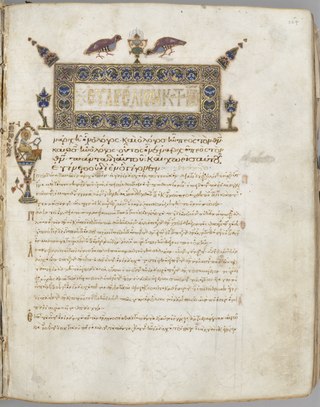
An illuminated manuscript is a formally prepared document where the text is decorated with flourishes such as borders and miniature illustrations. Often used in the Roman Catholic Church for prayers and liturgical books such as psalters and courtly literature, the practice continued into secular texts from the 13th century onward and typically include proclamations, enrolled bills, laws, charters, inventories, and deeds.

International Gothic is a period of Gothic art which began in Burgundy, France, and northern Italy in the late 14th and early 15th century. It then spread very widely across Western Europe, hence the name for the period, which was introduced by the French art historian Louis Courajod at the end of the 19th century.

The medieval art of the Western world covers a vast scope of time and place, with over 1000 years of art in Europe, and at certain periods in Western Asia and Northern Africa. It includes major art movements and periods, national and regional art, genres, revivals, the artists' crafts, and the artists themselves.

The Vienna Genesis, designated by siglum L (Ralphs), is an illuminated manuscript, probably produced in Syria in the first half of the 6th century. It is one of the oldest well-preserved, surviving, illustrated biblical codices; only the Garima Gospels of Ethiopia, dating to the 5th and 6th centuries, are as old or older.
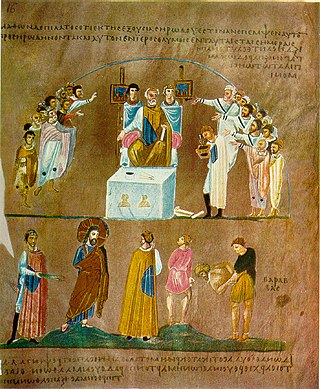
The Rossano Gospels, designated by 042 or Σ, ε 18 (Soden), held at the cathedral of Rossano in Italy, is a 6th-century illuminated manuscript Gospel Book written following the reconquest of the Italian peninsula by the Byzantine Empire. Also known as Codex purpureus Rossanensis due to the reddish-purple appearance of its pages, the codex is one of the oldest surviving illuminated manuscripts of the New Testament. The manuscript is famous for its prefatory cycle of miniatures of subjects from the Life of Christ, arranged in two tiers on the page, sometimes with small Old Testament prophet portraits below, prefiguring and pointing up to events described in the New Testament scene above.

The Biblioteca Ambrosiana is a historic library in Milan, Italy, also housing the Pinacoteca Ambrosiana, the Ambrosian art gallery. Named after Ambrose, the patron saint of Milan, it was founded in 1609 by Cardinal Federico Borromeo, whose agents scoured Western Europe and even Greece and Syria for books and manuscripts. Some major acquisitions of complete libraries were the manuscripts of the Benedictine monastery of Bobbio (1606) and the library of the Paduan Vincenzo Pinelli, whose more than 800 manuscripts filled 70 cases when they were sent to Milan and included the famous Iliad, the Ilias Picta.

Books of hours are Christian prayer books, which were used to pray the canonical hours. The use of a book of hours was especially popular in the Middle Ages, and as a result, they are the most common type of surviving medieval illuminated manuscript. Like every manuscript, each manuscript book of hours is unique in one way or another, but most contain a similar collection of texts, prayers and psalms, often with appropriate decorations, for Christian devotion. Illumination or decoration is minimal in many examples, often restricted to decorated capital letters at the start of psalms and other prayers, but books made for wealthy patrons may be extremely lavish, with full-page miniatures. These illustrations would combine picturesque scenes of country life with sacred images.

A miniature is a small illustration used to decorate an ancient or medieval illuminated manuscript; the simple illustrations of the early codices having been miniated or delineated with that pigment. The generally small scale of such medieval pictures has led to etymological confusion with minuteness and to its application to small paintings, especially portrait miniatures, which did however grow from the same tradition and at least initially used similar techniques.
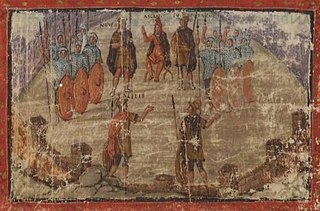
The Vergilius Vaticanus, also known as Vatican Virgil, is a Late Antique illuminated manuscript containing fragments of Virgil's Aeneid and Georgics. It was made in Rome in around 400 CE, and is one of the oldest surviving sources for the text of the Aeneid. It is the oldest and one of only three ancient illustrated manuscripts of classical literature.

The Vergilius Romanus, also known as the Roman Vergil, is a 5th-century illustrated manuscript of the works of Virgil. It contains the Aeneid, the Georgics, and some of the Eclogues. It is one of the oldest and most important Vergilian manuscripts. It is 332 by 323 mm with 309 vellum folios. It was written in rustic capitals with 18 lines per page.

The Rabbula Gospels, or Rabula Gospels is a 6th-century illuminated Syriac Gospel Book. One of the finest Byzantine works produced in West Asia, and one of the earliest Christian manuscripts with large miniatures, it is distinguished by the miniaturist's predilection for bright colours, movement, drama, and expressionism. Created during a period from which little art survived, it nevertheless saw great development in Christian iconography. The manuscript has a significant place in art history, and is very often referred to.
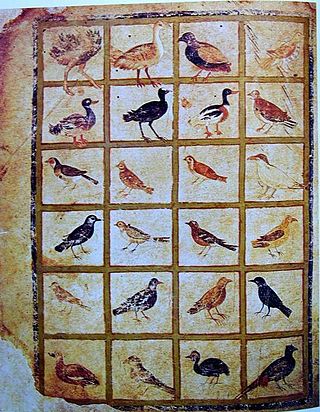
The Vienna Dioscurides or Vienna Dioscorides is an early 6th-century Byzantine Greek illuminated manuscript of an even earlier 1st century AD work, De materia medica by Pedanius Dioscorides in uncial script. It is an important and rare example of a late antique scientific text. After residing in Constantinople for just over a thousand years, the text passed to the Holy Roman Emperor in Vienna in the 16th century, a century after the city fell to the Ottoman Empire.

The Syriac Bible of Paris is an illuminated Bible written in Syriac. It dates to 6th or 7th century. It is believed to have been made in northern Mesopotamia. The manuscript has 246 extant folios. Large sections of text and the accompanying illustrations are missing. The folios are 312 by 230 mm. For reasons of economy, the text is written in three columns.
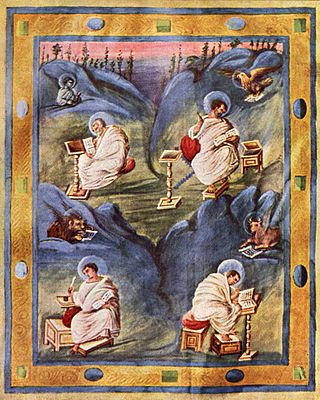
Carolingian art comes from the Frankish Empire in the period of roughly 120 years from about 780 to 900—during the reign of Charlemagne and his immediate heirs—popularly known as the Carolingian Renaissance. The art was produced by and for the court circle and a group of important monasteries under Imperial patronage; survivals from outside this charmed circle show a considerable drop in quality of workmanship and sophistication of design. The art was produced in several centres in what are now France, Germany, Austria, northern Italy and the Low Countries, and received considerable influence, via continental mission centres, from the Insular art of the British Isles, as well as a number of Byzantine artists who appear to have been resident in Carolingian centres.

Federico Borromeo was an Italian cardinal and Archbishop of Milan, a prominent figure of Counter-Reformation in Italy. Federico was a hero of the plague of 1630, described in Alessandro Manzoni's historical novel, The Betrothed. He was a great patron of the arts and founded the Biblioteca Ambrosiana, one of the first free public libraries in Europe. In 1618 he added a picture gallery, donating his own considerable collection of paintings. His published works, mainly in Latin, number over 100. They show his interest in ecclesiastical archaeology, sacred painting, and collecting.

The Paris Psalter is a Byzantine illuminated manuscript, 38 x 26.5 cm in size, containing 449 folios and 14 full-page miniatures. The Paris Psalter is considered a key monument of the so-called Macedonian Renaissance, a 10th-century renewal of interest in classical art closely identified with the emperor Constantine VII Porphyrogenitus (909-959) and his immediate successors.

The Joshua Roll is a Byzantine illuminated manuscript of highly unusual format, probably of the 10th century Macedonian Renaissance, believed to have been created by artists of the imperial workshops in Constantinople, and now in the Vatican Library.

The Belles Heures of Jean de France, Duc de Berry, or Belles Heures of Jean de Berry is an early 15th-century illuminated manuscript book of hours commissioned by the French prince John, Duke of Berry, around 1409, and made for his use in private prayer and especially devotions to the Virgin Mary. The miniatures of the Belles Heures are mostly painted by the Limbourg brothers; very few books of hours are as richly decorated as it.

The Menologion, Menologium, or Menology of Basil II is an illuminated manuscript designed as a church calendar or Eastern Orthodox Church service book (menologion) that was compiled c. 1000 AD for the Byzantine Emperor Basil II. It contains a synaxarion, a short collection of saints' lives, compiled at Constantinople for liturgical use and around 430 miniature paintings by eight different artists. It was unusual for a menologion from that era to be so richly painted. It currently resides in the Vatican Library . A full facsimile was produced in 1907.
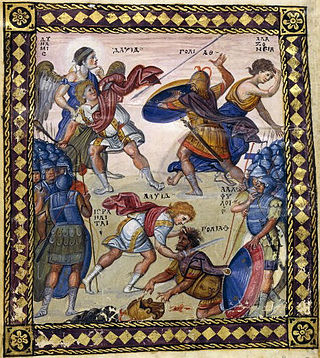
Byzantine illuminated manuscripts were produced across the Byzantine Empire, some in monasteries but others in imperial or commercial workshops. Religious images or icons were made in Byzantine art in many different media: mosaics, paintings, small statues and illuminated manuscripts. Monasteries produced many of the illuminated manuscripts devoted to religious works using the illustrations to highlight specific parts of text, a saints' martyrdom for example, while others were used for devotional purposes similar to icons. These religious manuscripts were most commissioned by patrons and were used for private worship but also gifted to churches to be used in services.






















